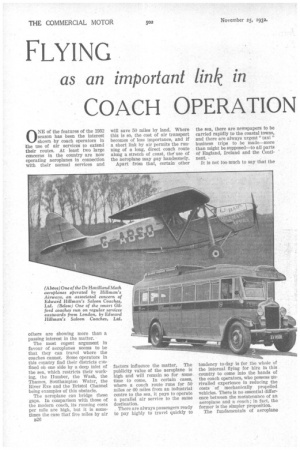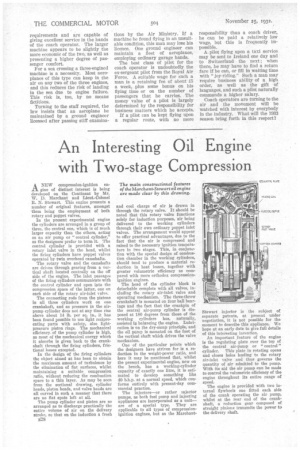FLYING
Page 44

Page 45

Page 46

If you've noticed an error in this article please click here to report it so we can fix it.
as an important link in
COACH OPERATION
Increasing Attention to Air Services Being Paid by Coaching Concerns. Valuable Advice on the Choice of Aeroplanes, Landing Grounds and Staff
ONE of the features of the 1932 season has been the interest shown by coach operators in the use of air services to extend their routes. At least two large concerns in the country are now operating aeroplanes in connection with their normal services and
others are showing more than a passing interest in the matter.
The most cogent argument in favour of aeroplanes seems to be that they can travel where the coaches cannot. Some operators in this country find their districts cqnfmed on one side by a deep inlet of the sea, which restricts their working, the Humber, the Wash, the Thames, Southampton Water, the River Exe and the Bristol Channel being examples of this obstacle.
The aeroplane can bridge these gaps. In comparison with those of the modern coach, its running costs per mile are high, but it is sometimes the case that five miles by air
B26 will save 50 miles by land. Where this is so, the cost of air transport becomes of less importance, and if a short link by air permits the running of a long, direct coach route along a stretch of coast, the' use of the aeroplane may pay handsomely.
Apart from that, certain other
factors influence the matter. The publicity value of the aeroplane is high and will remain. so for some time to come. In certain cases, where a coach route runs for 50 miles or 60 miles from an industrial centre to the sea, it pays to operate a parallel air service to the same destination.
There are always passengers ready to pay highly to travel quickly to the sea, there are newspapers to be carried rapidly to the coastal towns, and there are always urgent " taxi" business trips to be made—more than might be supposed—to all parts of England, Ireland and the Continent.
It is not too much to say that the tendency to-day is for the whole of the internal flying for hire in this country to come into the hands of the coach operators, who possess unrivalled experience in reducing the costs of mechanically propelled vehicles. There is no essential difference between the maintenance of an aeroplane and a coach ; in fact, the former is the simpler proposition.
The fundamentals of aeroplane operation are not alarming. An aerodrome of some sort is necessary and, for the class Of aeroplane in which the coach operator will be interested, this may be an ordinary pasture field. It should be about 35 acres in area, roughly square in shape, level and, so far as possible, free from tall trees or telegraph wires
at the boundaries. An income may be derived from the grazing of this field, the cattle seldom interfering with the operation of the aeroplanes.
The field should be situated close to a main road served by the coaches of the operator, and as near to the city as is practicable. The publicity value of a flying field beside a main road is considerable and this situation enables trips to be booked through by coach and aeroplane, with the minimum of delay. If a regular route is to be operated by air, a similar field must be provided at the other end, with another coach service to convey passengers upon their journey.
Rousing accommodation for the aircraft should be provided at one end of the route if regular operation throughout the year be contemplated, although for the summer mouths the average aeroplane is
sufficiently robust to "live" out-ofdoors without incurring any great deterioration. For a large, 10passenger machine the floor area of the hangar should be roughly 45 ft. by 60 ft., and, if a building of this size be provided, it will accommodate two or three smaller machines as well.
Turning to the types of aeroplane available, the coach operator is faced with a wide choice, and a few comments will be useful. First of all, the relative importance of speed and pay-load must be assessed. An aeroplane of a certain horse-power, capable of landing in and leaving a field of 35 acres, may be designed for high speed, or to carry a large pay-load, but it cannot be designed to do both.
For the coach operator, there is little object in purchasing a machine with a greater maximum speed than about 100 m.p.h., or a cruising speed of some 85 m.p.h. This is sufficiently high to enable the aeroplane to operate against the normal headwinds prevailing in this country and is, in fact, about the speed of the average light aeroplane.
The best way to assess the operating cost of any passenger aeroplane is upon a basis of the brake horse power per paying passenger. Aeroplane engines are rated in terms of their maximum brake horse-power, so that this figure is easily determined. The most economical types at present upon the market use about 35-40 b.h.p. per passenger.
If an aeroplane of about this horse-power is to operate with certainty from a 35-acre field, its minimum flying speed should not be more than approximately 48 m.p.h., or it will fail to take off in the required distance, This minimum speed must be taken with full load on board and at a good height, for the airspeed indicator frequently reads low when landing. With these figures in mind, the coach operator will be able to pick out the suitable machines from the many types which will be offered to him and will be able to select one or two• machines for demonstration in his own field.
In general, it may be said that the most commercial types at present upon the market are a singleengined machine carrying three passengers and a pilot, and a threeengined aircraft carrying 10 passengers, with a pilot. Both these modqls conform with the above requirements and are capable of giving excellent service in the hands of the coach operator. The larger machine appears to be slightly the more economic of the two, as well as presenting a higher degree of passenger comfort.
For a sea crossing a three-engined machine is a necessity. Most aeroplanes of this type can keep in the air on any two of the three engines, and this reduces the risk of landing in the sea due to engine failure. This risk is, too, by no means fictitious.
Turning to the staff required, the law insists that an aeroplane be maintained by a ground engineer licensed after passing stiff examina dons by the Air Ministry. If a machine be found flying in an unsuitable condition, this man may lose his licence. One ground engineer can maintain a fleet of aeroplanes, employing ordinary garage hands.
The best class of pilot for the coach operator is undoubtedly the ex-sergeant pilot from the Royal Air Force. A suitable wage for such a man is a retaining fee of about £5 a week, plus some bonus on his flying time or on the number of passengers that he carries. The money value of a pilot is largely determined by the responsibility for business matters which he accepts.
If a pilot can be kept flying upon a regular route, with no more responsibility than a coach driver, he can be paid a relatively low wage, but this is frequently impossible. A pilot flying upon a taxi service may be sent to Ireland one day and to Switzerland the next; when there, he may have to find a return fare if he can, or fill in waiting time with "joy-riding." Such a man may require business ability of a high order, as well as the gift of languages, and such a pilot naturally commands a higher salary.
Coach operators are turning to the air and the movement will be watched with interest by everybody in the industry. What will the 1933 season bring forth in this respect?




































































































